Table of Contents
Gipfeli, often called the Swiss croissant, is a beloved crescent-shaped pastry known for its delicate, flaky layers and rich buttery flavor. A staple in Swiss bakeries and breakfast tables, this pastry has a slightly denser texture than its French counterpart, making it a unique treat. The Gipfeli Recipe requires precision and patience, as it involves layering butter into the dough through a process similar to puff pastry. These pastries are often enjoyed with butter, jam, or even a savory filling, making them a versatile choice for any occasion. Whether you’re an experienced baker or a novice, mastering the art of Gipfeli will transport you straight to a Swiss café.
History and Origins of the Gipfeli Recipe
The Gipfeli Recipe has deep roots in Swiss baking traditions, where it has been a cherished breakfast item for centuries. While it shares similarities with the French croissant, Gipfeli is distinct in both texture and preparation. Unlike croissants, which are light and airy due to their high butter content, Gipfeli has a slightly firmer consistency, making them ideal for pairing with butter, jam, or even cheese.
The origins of Gipfeli can be traced back to Austria’s Kipferl, a crescent-shaped pastry that dates back to the 17th century. As Swiss bakers refined their own version, they created a pastry that better suited local tastes and baking traditions. Over time, the Gipfeli became a staple in Swiss households, often enjoyed with a strong cup of coffee or hot chocolate.
In modern Switzerland, Gipfeli is found in nearly every bakery, from bustling cities to quiet Alpine villages. The Gipfeli Recipe has also evolved to include variations such as Nussgipfel (nut-filled) and chocolate-filled versions, reflecting the country’s love for quality baked goods. Whether homemade or bought from a bakery, Gipfeli remains an integral part of Swiss culture.
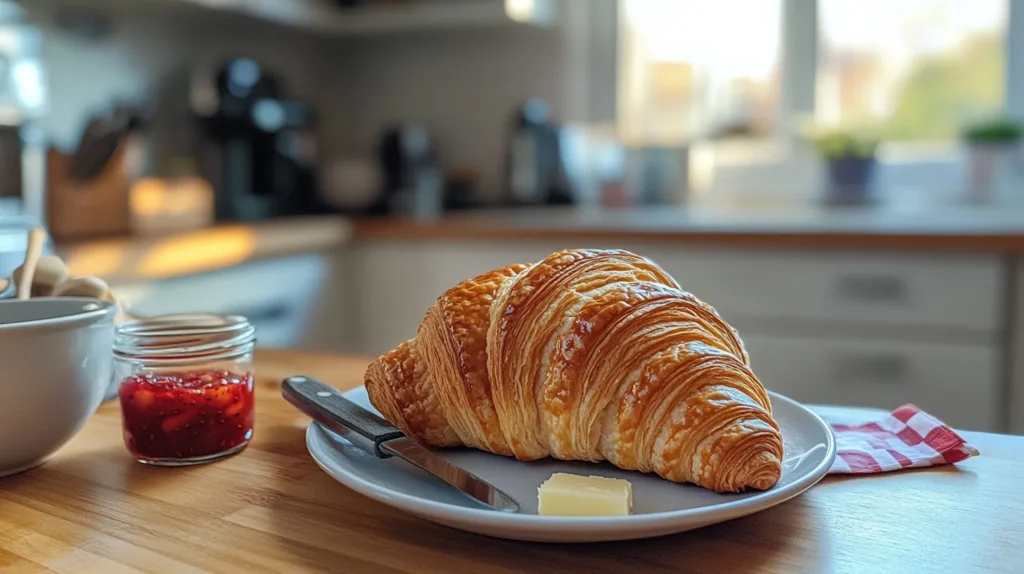
Traditional Gipfeli Recipe and Ingredients
The Gipfeli Recipe relies on simple yet high-quality ingredients to achieve its signature flaky texture and rich flavor. Unlike French croissants, Swiss Gipfeli contains slightly less butter, resulting in a denser yet still delicate pastry. The dough is layered multiple times to create light, crisp layers that make Gipfeli a delight to eat.
Key Ingredients for the Classic Gipfeli Recipe
- Flour – All-purpose flour is typically used, providing the necessary structure and elasticity for the dough.
- Yeast – Active dry yeast helps the dough rise, giving the pastry a slight lift.
- Milk – Lukewarm milk activates the yeast and adds moisture to the dough.
- Sugar – A small amount of sugar enhances the flavor without making the pastry overly sweet.
- Salt – Essential for balancing the flavor and strengthening the gluten structure.
- Eggs – Used in the dough for richness and in the egg wash to create a golden-brown finish.
- Butter – Chilled, high-quality butter is layered within the dough to achieve the flakiness characteristic of Gipfeli.
The Secret to a Perfect Gipfeli Recipe
The key to a great Gipfeli is the lamination process, where butter is folded into the dough multiple times to create thin, crisp layers. After resting, the dough is rolled out and shaped into crescents before being baked to perfection. While the process requires patience, the results are well worth the effort—yielding golden, buttery pastries that taste like they came straight from a Swiss bakery.
Variations of the Gipfeli Recipe
The classic Gipfeli Recipe is delicious on its own, but bakers across Switzerland have created a variety of flavorful adaptations to suit different tastes. These variations introduce fillings, toppings, and alternative dough preparations that make each version unique while maintaining the beloved flaky texture of traditional Gipfeli.
1. Nussgipfel (Nut-Filled Gipfeli)
One of the most popular variations, Nussgipfel is filled with a sweet nut mixture, often made from ground hazelnuts, almonds, sugar, and a touch of cinnamon. This version is slightly richer and pairs exceptionally well with coffee or tea.
2. Schokoladen-Gipfeli (Chocolate-Filled Gipfeli)
For those who love a sweet indulgence, Schokoladen-Gipfeli is the perfect choice. These pastries feature a rich chocolate filling, typically made with dark or milk chocolate pieces that melt inside the flaky layers during baking. Some bakers even drizzle extra chocolate on top for added decadence.
3. Vollkorn-Gipfeli (Whole Wheat Gipfeli)
For a healthier alternative, some Swiss bakers create Vollkorn-Gipfeli using whole wheat flour instead of white flour. While slightly denser, this version retains a satisfying crunch and a nutty flavor, making it a nutritious choice for breakfast.
4. Käse-Gipfeli (Cheese-Filled Gipfeli)
A savory twist on the traditional Gipfeli Recipe, Käse-Gipfeli features a melted cheese filling, often made with Gruyère or Emmental. Some variations include herbs or ham, turning this into a satisfying snack or light meal.
5. Buttergipfeli (Classic Buttery Version)
If you prefer to keep things traditional, the Buttergipfeli is the standard Swiss version—flaky, buttery, and slightly denser than a French croissant. It’s best enjoyed fresh from the oven with a simple spread of butter and jam.
Each of these variations adds a unique touch to the Gipfeli Recipe, making it a versatile pastry suitable for different preferences and occasions. Whether you prefer sweet, savory, or wholesome options, there’s a Gipfeli for everyone.
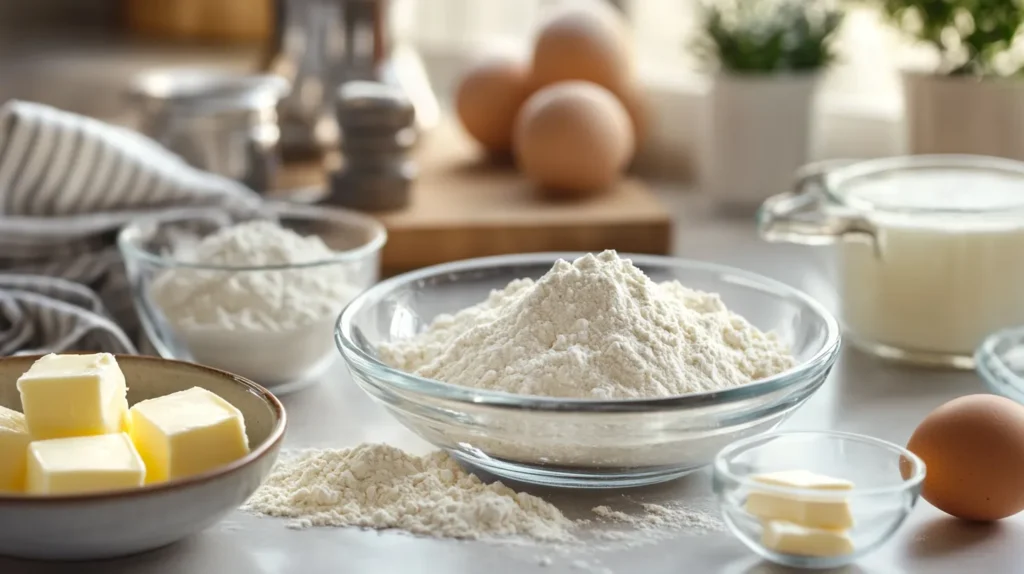
Expert Tips for a Flawless Gipfeli Recipe
Mastering the Gipfeli Recipe requires precision, patience, and attention to detail. While the process may seem complex, following these expert tips will help you achieve bakery-quality results at home.
1. Perfecting the Dough
- Use high-quality flour to ensure the dough has enough gluten strength for proper layering.
- Knead the dough thoroughly until it becomes smooth and elastic—this step is crucial for structure and flakiness.
- Allow the dough to rise slowly in a cool environment to develop deeper flavor.
2. Mastering the Butter Lamination
- Use chilled but pliable butter to create the delicate layers; it should be cold but soft enough to roll without breaking.
- When rolling out the dough, work quickly to prevent the butter from melting, which can ruin the lamination.
- Fold and roll the dough carefully, ensuring that each fold creates even layers for a consistent flaky texture.
3. Shaping the Gipfeli
- Cut the dough into evenly sized triangles to ensure uniform baking.
- Make a small slit at the base of each triangle before rolling—it helps create the perfect crescent shape.
- Roll the dough gently but firmly, stretching slightly to encourage a layered structure.
4. The Baking Process
- Preheat your oven properly to ensure even baking—Gipfeli require high heat to achieve the perfect golden crust.
- Brush the pastries with an egg wash (egg yolk mixed with milk) for a glossy, golden-brown finish.
- Start at a higher temperature (400°F/200°C) for the first few minutes, then reduce slightly to ensure even baking without over-browning.
5. Storing and Serving
- Gipfeli are best enjoyed fresh, ideally within a few hours of baking.
- If you need to store them, keep them in an airtight container at room temperature for up to a day.
- To reheat, place in a preheated oven at 350°F (175°C) for a few minutes to restore crispness.
By following these tips, you can elevate your Gipfeli Recipe to professional quality, ensuring light, flaky, and perfectly golden pastries every time.
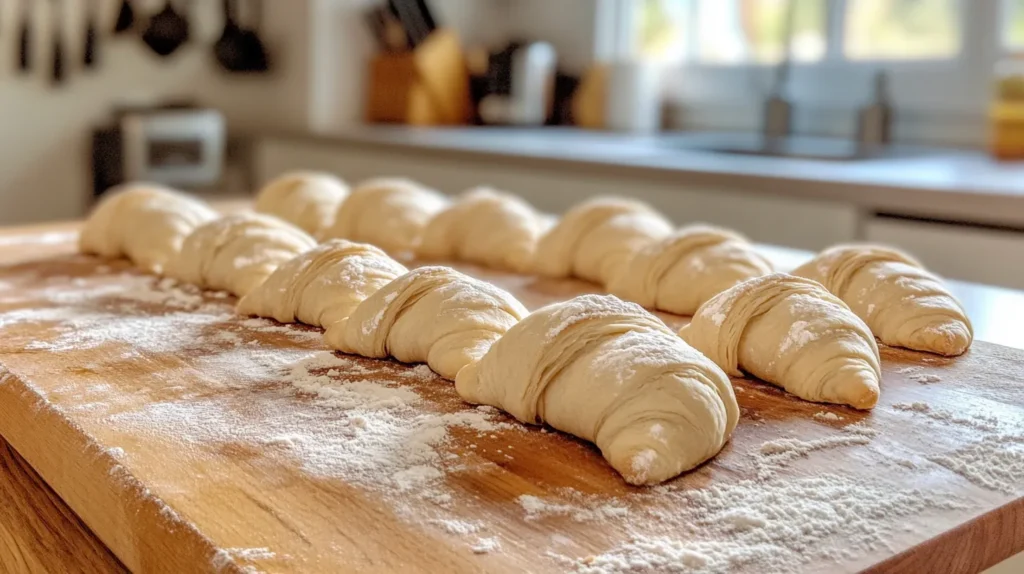
Serving Suggestions and Pairings for Gipfeli Recipe
Once you’ve perfected your Gipfeli Recipe, the next step is serving them in the most delicious way possible. Whether you prefer a sweet or savory touch, there are countless ways to enjoy these Swiss pastries. Here are some of the best accompaniments and pairings to elevate your Gipfeli experience.
1. Classic Swiss Breakfast Pairings
- Butter and Jam – A traditional Swiss favorite, spreading fresh butter and fruit jam (such as apricot, raspberry, or cherry) over a warm Gipfeli enhances its natural flavor.
- Honey – Drizzle some high-quality Swiss honey over your Gipfeli for a sweet and natural touch.
- Cheese and Cold Cuts – Pairing Gipfeli with mild Swiss cheeses like Emmental or Gruyère and some thinly sliced ham or salami creates a balanced and satisfying breakfast.
2. Coffee and Beverage Pairings
- Swiss Coffee (Café Crème) – A smooth, creamy Swiss-style coffee perfectly complements the buttery layers of a Gipfeli.
- Hot Chocolate – A rich, velvety hot chocolate is an indulgent pairing, particularly during cold mornings.
- Tea Selection – A light black tea, Earl Grey, or chamomile tea brings out the delicate flavors of Gipfeli without overpowering them.
3. Gourmet Dessert Options
- Nutella or Chocolate Spread – For a sweet treat, serve warm Gipfeli with a side of Nutella or melted Swiss chocolate.
- Whipped Cream and Berries – Fresh strawberries, raspberries, or blueberries with a dollop of whipped cream can turn your Gipfeli into an elegant dessert.
- Pastry Cream or Custard – For an extra indulgent twist, cut a Gipfeli in half and fill it with vanilla pastry cream or almond cream.
4. Savory Gipfeli Combinations
- Herb Butter and Smoked Salmon – A savory take on the Gipfeli Recipe, topping it with herbed butter and smoked salmon makes for a sophisticated brunch option.
- Scrambled Eggs and Avocado – For a more filling meal, pair Gipfeli with scrambled eggs and a side of sliced avocado.
- Spicy Cheese Spread – Adding a creamy cheese spread with a hint of spice brings a bold contrast to the mild sweetness of the pastry.
5. Storing and Reheating for the Best Experience
- If you have leftover Gipfeli, store them in an airtight container at room temperature for up to a day.
- To refresh their crispness, reheat in a preheated oven at 350°F (175°C) for a few minutes—this helps restore the flakiness without drying them out.
- Avoid microwaving as it can make them soggy instead of crispy.
The Gipfeli Recipe is a versatile delight, whether you enjoy it with a simple butter spread or as part of an elaborate breakfast or brunch. Experiment with different pairings to discover your favorite way to enjoy this iconic Swiss pastry.
Print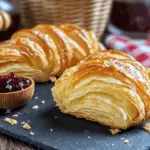
Gipfeli Recipe
- Total Time: 4 hours 30 minutes
- Yield: 12 Rolls 1x
Description
This Gipfeli recipe is a light and flaky Swiss pastry, perfect for pairing with butter and jam. These crescent-shaped rolls are rich, buttery, and deliciously golden-brown.
Ingredients
For the Dough:
- 2 1/4 teaspoons 7 grams active dry yeast
- 1 1/3 cups 315 milliliters lukewarm milk (105-115°F, 40-46°C)
- 4 cups 500 grams all-purpose flour
- 3 tablespoons 38 grams granulated sugar
- 1 1/2 teaspoons salt
- 1 large egg
For Assembly:
- 1 cup 226 grams unsalted butter, chilled
- 1 egg yolk
- 1 tablespoon 15 milliliters milk
Instructions
Making the Dough
- Step 1 To begin, sprinkle the yeast over the lukewarm milk in a small bowl. Stir briefly and let it sit for about 10 minutes until it becomes frothy. In a stand mixer fitted with a dough hook or a large bowl, combine the flour, sugar, and salt. Slowly add the yeast mixture and egg into the dry ingredients, mixing until a soft dough forms. If the dough feels crumbly, add a little more milk; if too sticky, add a bit more flour. Knead the dough on a lightly floured surface until smooth and elastic, then transfer it to a large bowl. Cover and let it rise at room temperature until doubled in size, about 1 1/2 hours.
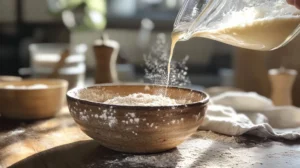
Laminating the Dough
- Step 2 During the final 30 minutes of rising, prepare the butter layer by slicing the chilled butter into 1/2-inch (1.25 cm) thick pieces. Arrange them into an 8×8-inch (20×20 cm) square on parchment paper, cover with another parchment sheet, and pound with a rolling pin until it forms a 9×9-inch (23×23 cm) square. Refrigerate for 10 minutes until cool but pliable. Roll out the dough to an 18×10-inch (46×25 cm) rectangle and place the butter over half of the dough. Fold the dough over the butter, sealing the edges. Wrap in plastic and refrigerate for 30 minutes. Roll the dough into a 16×10-inch (41×25 cm) rectangle, fold it into thirds, and refrigerate again for 30 minutes. Repeat this rolling and folding process two more times, always chilling for 30 minutes after each fold. After the final fold, refrigerate for an additional 30 minutes.
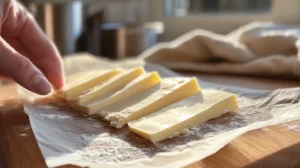
Shaping and Baking the Gipfeli
- Step 3 Line two baking sheets with parchment paper. Divide the dough in half, keeping one half refrigerated while working with the other. Roll the dough into an 18×6-inch (46×15 cm) rectangle, then cut it into six triangles with a 5-inch (13 cm) base. Make a small 1-inch (2.5 cm) cut at the center of each base to help shape the crescents. Roll the triangles from base to tip, slightly turning the ends inward to form the classic crescent shape. Arrange them on the baking sheet, spacing them 2 inches (5 cm) apart. Repeat with the remaining dough. Cover lightly with a towel and let rise for 1 hour. Preheat the oven to 400°F (200°C). Whisk together the egg yolk and milk, then brush it over the pastries. Bake for 5 minutes, then reduce the temperature to 375°F (190°C) and bake for another 10-12 minutes until golden brown.

Notes
Serve warm with butter and jam.
Best enjoyed within a few hours of baking.
Store in an airtight container at room temperature for up to 2 days or freeze for up to 1 month.
- Prep Time: 45 minutes
- Cook Time: 15 minutes
- Category: Bread
- Cuisine: Swiss
Nutrition
- Calories: 250
Frequently Asked Questions (FAQ)
u003cstrongu003eWhat is the difference between a croissant and a Gipfeli?u003c/strongu003e
A croissant is a French pastry known for its extremely flaky, buttery, and airy texture due to its high butter content and multiple laminations. A Gipfeli, the Swiss version, is slightly denser, contains less butter, and has a more structured texture. Unlike croissants, Gipfeli often have a firmer crust and are less sweet.
u003cstrongu003eWhat are the ingredients in Nussgipfel?u003c/strongu003e
Nussgipfel, a nut-filled variation of Gipfeli, typically includes all-purpose flour, yeast, milk, sugar, salt, butter, and eggs for the dough. The nut filling is usually made from ground hazelnuts or almonds, sugar, cinnamon, and sometimes egg whites or cream to create a smooth paste.
u003cstrongu003eWhat ingredients are in a croissant?u003c/strongu003e
A traditional croissant contains flour, butter, milk, sugar, salt, yeast, and water. The key to its flaky layers is the lamination process, where butter is folded into the dough multiple times to create thin, crisp layers when baked.
u003cstrongu003eWhat is the Swiss version of a croissant?u003c/strongu003e
The Swiss version of a croissant is called Gipfeli. It is similar in shape but has a firmer texture and is less buttery and flaky than a traditional French croissant. Swiss Gipfeli can be either plain or filled with nuts, chocolate, or cheese, making them a versatile breakfast or snack option.
Conclusion
The Gipfeli Recipe is a testament to Swiss baking traditions, offering a delicious alternative to the French croissant. With its slightly denser texture and rich, buttery layers, Gipfeli has become a beloved breakfast staple in Switzerland and beyond. Whether enjoyed plain, with butter and jam, or as a filled variation like Nussgipfel or Schokoladen-Gipfeli, this pastry provides endless possibilities for both sweet and savory pairings.
Mastering the art of Gipfeli requires patience, attention to detail, and quality ingredients, but the results are well worth the effort. By following expert tips on dough preparation, butter lamination, and baking techniques, you can recreate the authentic Swiss experience at home. Whether served fresh with coffee or as part of a gourmet breakfast, Gipfeli remains a timeless delight that brings a taste of Switzerland to your kitchen.

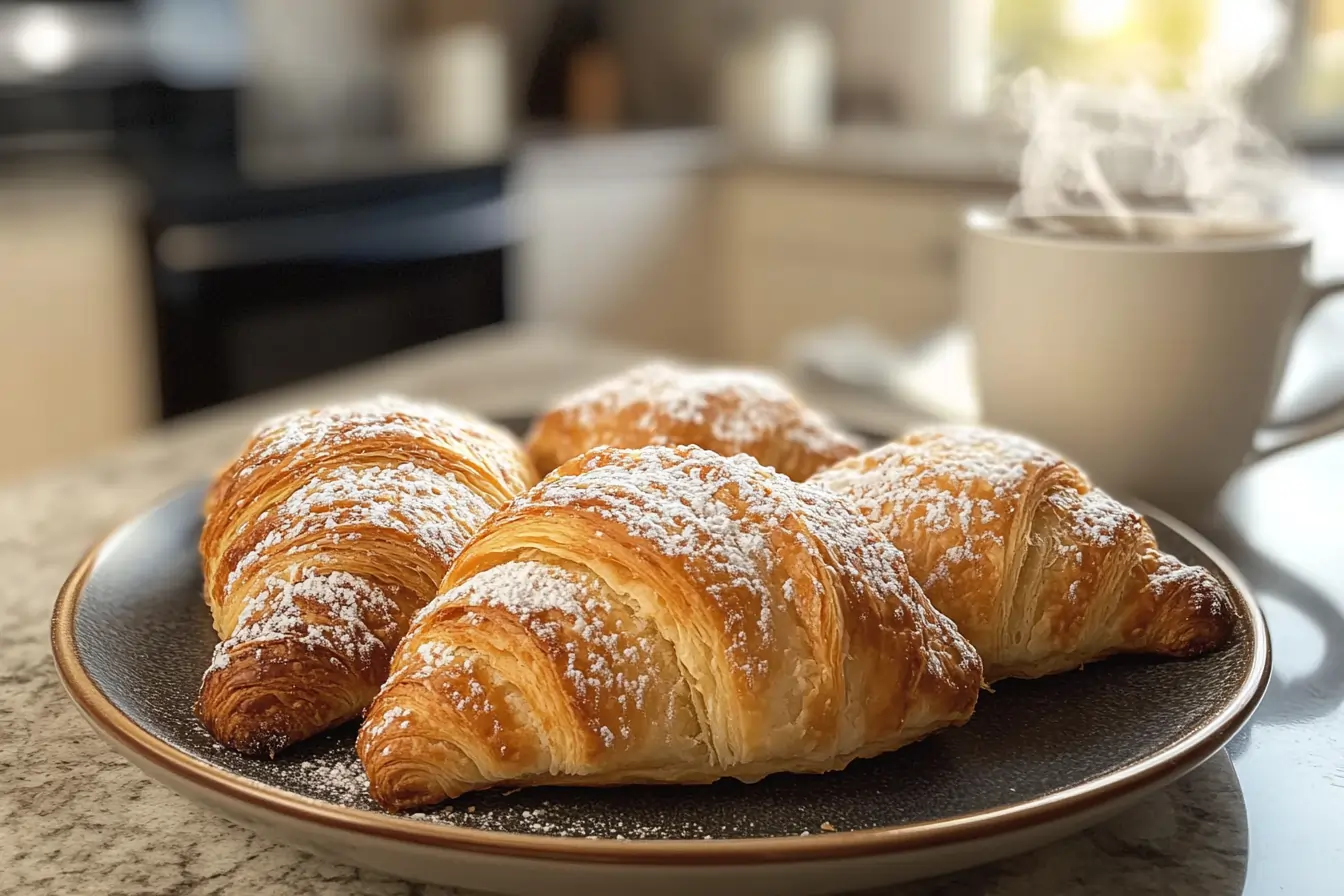

I’ve made these three times now, and I (and my family) love them! My only problem is, I can’t seem to get them all a uniform size. I suppose that’s just down to practice…